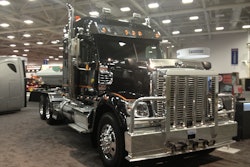As temperatures begin to drop, fleet managers around the country will lift the hoods on trucks nationwide and top off their coolant levels. Many of them don’t even know why.
It’s just something you do when it gets cold, right?
RELATED: Prestone Command training
Behind replenishing coolant levels is science, and a lot of it.
“What we found out in the real world of fleets is that when it comes to wintertime, they try to make sure their percent glycol in their formula is correct,” says Colin Dilley, Director of Technology at the Prestone Technology Center. “They’re not thinking so much of corrosion protection.”
While freezing is mostly a seasonal concern, corrosion protection is a daily concern, Dilley says, noting that routine winter level inspections are a good time to check the overall effectiveness of the coolant.
“Winter is the perfect time to do the array of testing both on glycol percent, which shows you what your freeze-point will be, and also it shows you how much of the inhibitors you actually have in your system and whether or not it’s time to do a more significant change,” he says, adding that coolant inspection is a three-step process.
Step One: Test your glycol for freeze-point
Step Two: Test it for inhibitors to make sure you’re still getting the correct corrosion protection.
Step Three: Make sure you’ve got the right volume in your cooling system so you’re not getting air pockets.
“One of the biggest concerns with corrosion is air entrapment in the engine,” he says. “This is the ideal time to make sure your engine is full and topped-off. And that should be done on a regular basis, and it should be in your maintenance schedules.”
When it comes to drain or replacement intervals, Dilley says its best to follow engine manufacturer guidelines, unless routine testing reveals a change is needed earlier.
RELATED: Prestone publishes white paper
Water is essentially the only ingredient in anti-freeze that is capable of freezing, and at least one company has eliminated that element from its blend.
Mike Tourville, Marketing Director, Evans Cooling Systems, says the absence of water in the Evans means the product won’t expand as temperatures dip below freezing.
“Our coolant does not expand, it actually contracts in colder weather,” he says.
Ice itself isn’t what damages a truck’s coolant system; it’s the formation of the ice and the resulting expansion of liquid in the freezing process that can crack cooling system plumbing.
“Our coolant condenses a little bit when it’s cold,” Tourville says. “It turns a little slushy, thicker, when it gets in the minus 40, minus 50 range. Therefore you minimize the chance of cracking any metals.”
While the coolant does condense, Tourville says it doesn’t contract enough to introduce air into the system.
Another advantage of waterless coolants, Tourville says, is that Evans’ blend doesn’t require the same amount of additives because it doesn’t have to protect against the effects of water in the formula.
“A lot of the (anti-corrosive) additives in water-based coolants are soluble in water and they eventually fall out,” he says. “They eventually settle. The additives that we have don’t settle out and the coolant keeps its integrity for years and years provided it doesn’t get contaminated.”
That translates to a coolant that can last much longer than conventional counterparts, although Tourville still recommends routine inspection.
“It’s just a good practice,” he says.









